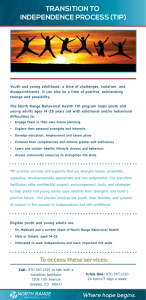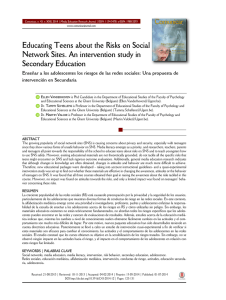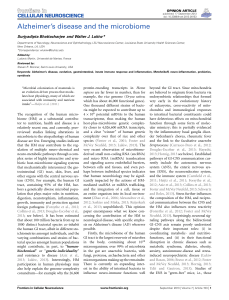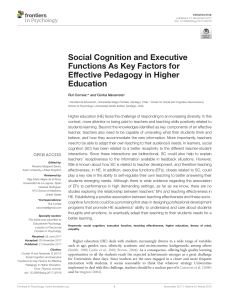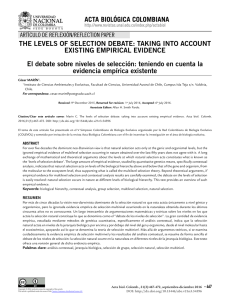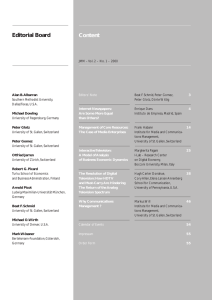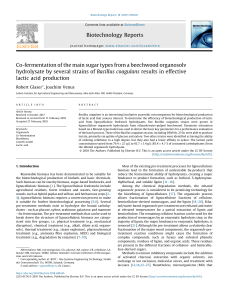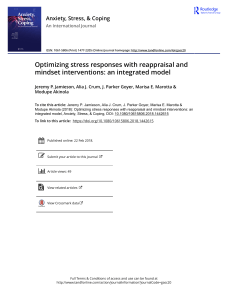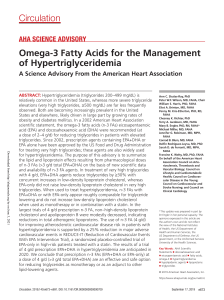Beyond Newspapers: News Consumption among Young People in
Anuncio
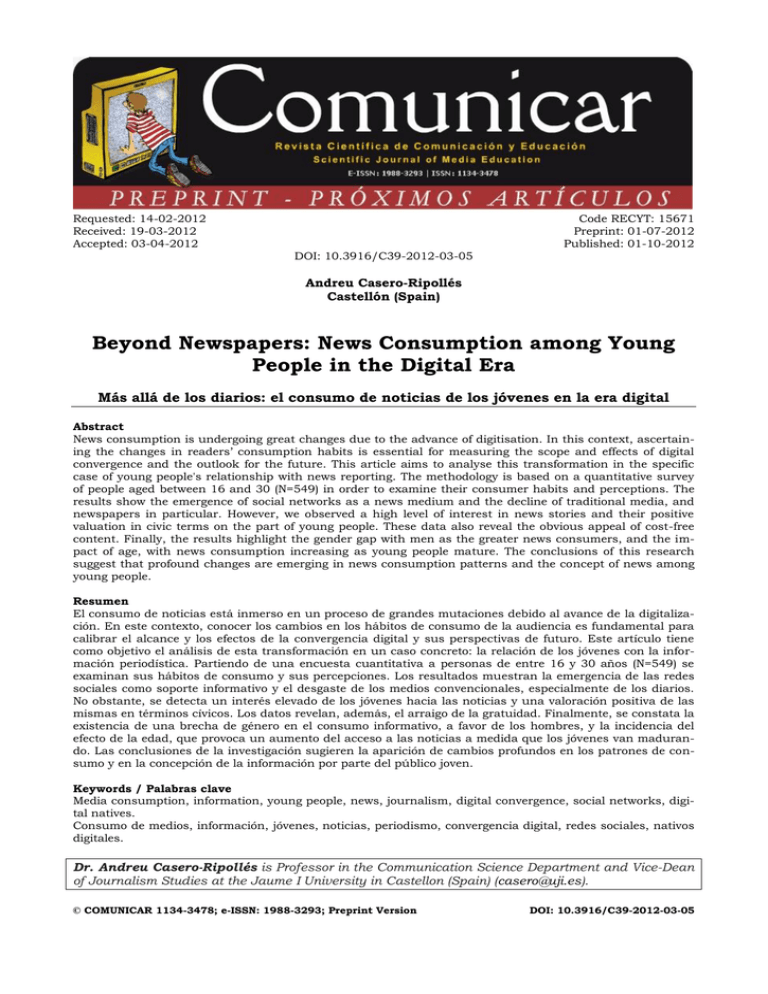
Requested: 14-02-2012 Received: 19-03-2012 Accepted: 03-04-2012 Code RECYT: 15671 Preprint: 01-07-2012 Published: 01-10-2012 DOI: 10.3916/C39-2012-03-05 Andreu Casero-Ripollés Castellón (Spain) Beyond Newspapers: News Consumption among Young People in the Digital Era Más allá de los diarios: el consumo de noticias de los jóvenes en la era digital Abstract News consumption is undergoing great changes due to the advance of digitisation. In this context, ascertaining the changes in readers’ consumption habits is essential for measuring the scope and effects of digital convergence and the outlook for the future. This article aims to analyse this transformation in the specific case of young people's relationship with news reporting. The methodology is based on a quantitative survey of people aged between 16 and 30 (N=549) in order to examine their consumer habits and perceptions. The results show the emergence of social networks as a news medium and the decline of traditional media, and newspapers in particular. However, we observed a high level of interest in news stories and their positive valuation in civic terms on the part of young people. These data also reveal the obvious appeal of cost-free content. Finally, the results highlight the gender gap with men as the greater news consumers, and the impact of age, with news consumption increasing as young people mature. The conclusions of this research suggest that profound changes are emerging in news consumption patterns and the concept of news among young people. Resumen El consumo de noticias está inmerso en un proceso de grandes mutaciones debido al avance de la digitalización. En este contexto, conocer los cambios en los hábitos de consumo de la audiencia es fundamental para calibrar el alcance y los efectos de la convergencia digital y sus perspectivas de futuro. Este artículo tiene como objetivo el análisis de esta transformación en un caso concreto: la relación de los jóvenes con la información periodística. Partiendo de una encuesta cuantitativa a personas de entre 16 y 30 años (N=549) se examinan sus hábitos de consumo y sus percepciones. Los resultados muestran la emergencia de las redes sociales como soporte informativo y el desgaste de los medios convencionales, especialmente de los diarios. No obstante, se detecta un interés elevado de los jóvenes hacia las noticias y una valoración positiva de las mismas en términos cívicos. Los datos revelan, además, el arraigo de la gratuidad. Finalmente, se constata la existencia de una brecha de género en el consumo informativo, a favor de los hombres, y la incidencia del efecto de la edad, que provoca un aumento del acceso a las noticias a medida que los jóvenes van madurando. Las conclusiones de la investigación sugieren la aparición de cambios profundos en los patrones de consumo y en la concepción de la información por parte del público joven. Keywords / Palabras clave Media consumption, information, young people, news, journalism, digital convergence, social networks, digital natives. Consumo de medios, información, jóvenes, noticias, periodismo, convergencia digital, redes sociales, nativos digitales. Dr. Andreu Casero-Ripollés is Professor in the Communication Science Department and Vice-Dean of Journalism Studies at the Jaume I University in Castellon (Spain) ([email protected]). © COMUNICAR 1134-3478; e-ISSN: 1988-3293; Preprint Version DOI: 10.3916/C39-2012-03-05 1. Introduction Digitisation has brought changes to the communicative system, with content production, work routines, media and distribution strategies and business models all undergoing important alterations. Public consumption patterns are also transforming and substantially modifying the system’s traditional dynamics. In this context, ascertaining the changes in readers’ consumption habits is essential for measuring the scope and effects of digital convergence and the outlook for the future, and to that end this article focuses on the analysis of information consumption in a specific age group: young people. They are pioneers in assimilating technological innovations related to digitisation, and for this they are known as digital natives (Prensky, 2001; Palfrey & Gasser, 2008) or members of the interactive generation (Bringué & Sádaba, 2009). Their condition as early users (Livingstone & Bovill, 1999) makes them a priviliged case study for exploring the changes that have resulted from the impact of the digital era. In order to study news consumption in the convergence frame, this article begins with an examination of newspapers which later extends to general information, regardless of format. There are different reasons that justify this choice: newspapers have traditionally been considered the main referent source of information (Corroy, 2008). Moreover, they have been the subject of most investigations focused on the study of the relationship between young people and news (Qayyum & al., 2010), and are undergoing a process of redefinition caused by the current financial crisis (Casero-Ripollés, 2010). However, this article is not just confined to newspapers, as convergence imposes the predominance of interconnections and interdependences within the media scenario. The aims of this investigation are: 1) To ascertain young people’s news consumption habits, particularly of newspaper, in the digital era. 2) To discover the attitudes and perceptions of young people towards journalistic information. The hypotheses of the investigation connected to the above aims are: - H1. Young people’s news consumption goes beyond newspapers, which are read less and less, and encompass a wide variety of media, especially online media. - H2. Young people show great interest in information, and attribute positive values to it. 2. Literature review Scientific investigation of young people’s news consumption habits has focused mainly on the analysis of newspapers. These studies have confirmed a consistent decline in readership among this age group, a tendency that began in the mid-Nineties (Lauf, 2001) and which affects most European countries (Brites, 2010; Lipani, 2008; Raeymaeckers, 2004) including Spain. The percentage of young people between 18 and 25 who consume print media is 25.7 (AEDE, 2010). Other investigations also confirm this rift between young people and newspapers in Spain (Navarro, 2003; Arroyo, 2006; Túñez, 2009; Parratt, 2010). There are many reasons that explain the decline in young people’s newspaper consumption: lack of time, preference for other media, and little interest in the content (Huang, 2009; Bernal, 2009; Costera, 2007; Raeymaeckers, 2002). The near irrelevance of news in their daily lives and the lack of a connection to their personal experiences and interests are key factors (Patterson, 2007; Vanderbosch, Dhoets & Van der Bulck, 2009; Qayyum et al., 2010). Young people not only fail to see themselves reflected in newspapers or conventional media (Domingo, 2005), but feel that they are marginal to their agenda setting. In this sense, the invisibility of young people in the news has been verified (Figueras & Mauri, 2010; Kotilainen, 2009) and the negativity that frequently attaches to them has also been confirmed (Túñez, 2009; Faucher, 2009; Bernier, 2011). All this is matched by the transformation arising from the digital convergence (Islas, 2009) that leads to a multi-screen society (Pérez-Tornero, 2008) which in turn also has an effect. The emergence of windows and news providers promoted by the Internet generate an overabundance of news and strong competition for readers’ attention, which also partly explains this phenomenon of decline. Scientific literature also points to parental influence as a significant impact on young people’s press consumption (Qayyum & al., 2010; Huang, 2009; Costera, 2007; Raeymaeckers, 2004; 2002). Young people’s news consumption is conditioned by two key factors: the age effect, as people get older they consume more and show greater interest in news (Qayyum et al., 2010; Huang, 2009; Lipani, 2008); the second factor is related to genre. Some authors detect a gap that sees men’s consumption become more intense than women’s (Brites, 2010; Raeymaeckers, 2004; Navarro, 2003; Lauf, 2001). © COMUNICAR 1134-3478; e-ISSN: 1988-3293; Preprint Version DOI: 10.3916/C39-2012-03-05 The distancing between young people and newspapers has three consequences. Firstly, the decline in young newspaper readers means the loss of an important potential market, and therefore, a fall in circulation and profits (Arnould, 2004). Secondly, the ageing of newspaper consumers does not guarantee a generational shift in readers (Lauf, 2001). Finally, newspapers have traditionally been considered the primary access point to public affairs (Brites, 2010), and also a socializing agent of politics for young people (Romer, Jamieson & Pasek, 2009). In this sense, the lack of interest in the press could diminish young people’s civic consciousness. 3. Methodology The methodological design of this investigation is based on a quantitative survey. This technique aims to obtain data about objective aspects (frequencies) and subjective aspects (opinions and attitudes) based on the information from individual interviews. The questionnaire is formed of three types of close-ended questions: dichotomous choice, multiple choice and open-ended questions, using a set of values from 0 to 10. The study combines single-answer with multiple choice questions. The field survey was carried out from January to April 2011. The procedure used was the face-toface interview method. Subsequently, the data were treated with the statistical program SPSS. Age and genre have been used as dependent variables while consumption and information perceptions are taken to be independent variables. The former include the frequency of reading newspapers, the way they access news, the number of media used to get informed, and payment predisposition. The latter focus on interest in news, and the civic values attributed to it. The study population is made up of 16 to 30-year-olds living in Catalonia (Spain), a segment which numbers 1,.284,005 individuals according to Idescat data from 2009. The sample is formed of 549 surveys randomly selected. The genre distribution of the sample is 45.35% men and 54.65% women. 4. Results 4.1. Frequency of newspaper reading Young people who state that they read the press everyday account for 28.8% of the total (Table 1), which signifies reduced newspaper consumption among this age group. Everyday Several times a week Once a week Once a month or more Very sporadically Never Total 16-17 Years old 18-20 Years old 21-22 Years old 28.8 10.7 28.5 28.1 42.3 26.8 44.8 43.8 12.9 19.6 12.3 13.3 4.4 12.5 4.7 2.3 8.2 17.9 7.6 7.8 3.5 12.5 2.2 4.7 23 or older 42 42 10.2 1.1 4.5 0 Men 40.6 38.2 7.6 3.2 5.2 5.2 Women 19 45.7 17.3 5.3 10.7 2 Table 1: Frequency of newspaper reading per age segment (in %). The results reinforce the importance of the age effect on newspaper consumption; as readers get older, they mature and their interest in the press rises, hence the increase by 31.3 points between 16-17 year olds and those 23 or older (Table 1). These data demonstrate that as young people get older they acquire a greater need to be informed and a stronger interest in news, and at the same time their cognitive capacity to consume news grows (Huang, 2009). Two factors explain this: young people identify newspapers with the adult world (Raeymaeckers, 2004); young people have a utilitarian view of press - when the topics and content affect them directly they will read them, if not, they will ignore them as they their content and format do not fit their needs and expectations (Vanderbosch, Dhoets & Van der Bulck, 2009). In this sense, most young people associate newspaper consumption to professional activity and their incorporation into the labor market (Lipani, 2008). The genre variable corroborates that young men read newspapers more than women. The survey shows that 40.6% of men read the press every day, while women register 19% (Table 1), revealing a clear genre gap in newspaper consumption. 4.2. Accessing media Today’s overabundance of information is due to the fact that news is not only provided by newspapers. Young people now have a wide range of media to choose from to get information and the results indicate that they indeed use several platforms to read the news. The use of television © COMUNICAR 1134-3478; e-ISSN: 1988-3293; Preprint Version DOI: 10.3916/C39-2012-03-05 (watched by 72.1% of those polled) is significant but secondary to the social networks as a media for news consumption among young people (Table 2). Websites such as Facebook or Tuenti are now the leading information outlets for young people (77.4%), which is especially relevant for two reasons. Firstly because it verifies that young people’s information consumption is increasingly online (Parratt, 2010), specifically via social networks. This predominance of social networks in young people’s accessing of news is one of the main contributions of this investigation. This feature also points to a shift in the use of social networks among young people. Until now several studies (Livingstone, 2008; Campos Freire, 2008; Boyd &Ellison, 2008; Carlsson, 2011) have highlighted the preeminently communicative function of social networks as young people use them to get in touch and interact with friends, as well as being a channel for self-expression. These new data show that social networks are now also used as means to read the news. This change also emphasizes that young people increasingly turn to mass media websites to access news (56.6%), compared to paid-for newspapers (33.2%) and the cost-free press (36.4%). The mobile phone at 28.4%, is yet to consolidate as a window for news consumption among young people (Table 2). The genre variable also reveals differences in preferences for news media among young people. Men score higher when selecting platforms and devices, except for television, digital tablets and the cost-free press where women score higher (Table 2). Men predominate in the use of social neteworks and mass media websites for news gathering. Total Paid-for print media (newspaper) Cost-free print media (newspaper) Radio Television Website (mass media) Blog Social network (Facebook, Tuenti, etc.) Twitter Mobile Telephone Digital Tablet (iPad, etc.) 33.2 36.4 26.6 72.1 56.6 3.3 77.4 17.1 28.4 0.7 16-17 Years old 18-20 Years old 28.6 32.1 17.9 80.4 44.6 0 75 5.4 10.7 1.8 33.9 40.1 24.2 74 51.3 3.2 76.2 18.8 24.9 0 21-22 Years old 32.8 33.6 27.3 71.1 60.2 3.9 75 18 35.2 2.3 23 or older 34.1 31.8 38.6 62.5 76.1 4.5 86.4 18.2 40.9 0 Men Women 33.7 31.7 28.9 71.5 65.5 3.6 82.3 19.3 30.9 0.4 32.7 40.3 24.7 72.7 49.3 3 73.3 15.3 26.3 1 Table 2: Preffered media for news consumption (multiple choice response in %). The age variable confirms thatthe use of all media for news consumption grows as young people mature. Use of paid-for newspapers, radio, blogs, Twitter, social networks, mobile telephone and mass media websites increases as a result (Table 2). By contast, , watching television for news decreases as people get older, confirming the decline in prominence of this audiovisual medium among the young due to the emergence of new media in recent years (García Matilla & Molina Cañabate, 2008; López Vidales, González Aldea & Medina de la Viña, 2011). 4.3. Diversity The results of our poll reveal that young people use a fairly wide range of mass media to get information, with 73% stating that they frequently use two to three different media to access news (Table 3). These data coincide with the study by Brites (2010: 185) who detected that young Portuguese aged 15 to 17 used an average of three different news sources. So, we can assume that young people’s news consumption is not restricted to a single medium, since this habit represents only 6% of the total (Table 3). This tendency, although not very high as only 4.9% consult more than five different media, shows that there is no longer a cognitive dependence on a single news source. The reasons behind this remarkably diverse competence among young people to seek out news are numerous: Internet makes access to information easy, the increase in information on offer by the news media system and its sheer diversity. This diversity of news-providing media directly affects the forming of public opinion and its very richness, which is explained by the wide variety of points of view on any event and the elements that enable the reader to form an opinion (Kotilainen, 2009). © COMUNICAR 1134-3478; e-ISSN: 1988-3293; Preprint Version DOI: 10.3916/C39-2012-03-05 In the same way, the range of media used by young people to access news is related to drastic changes in the way they process information (Rubio, 2010). The habit of channel-surfing acquired from TV watching is applied to news consumption in order to get a general impression of current affairs (Costera, 2007). That means an alteration in the traditional order of reading the news, from a linear, progressive reading to a non-sequential, diagonal, interrupted and hypertext reading (Domínguez Sánchez & Sádaba Rodríguez, 2005). The fact that young people use different news sources is connected to the transformation in their information consumption habits (Qayyum & al., 2010). Total 16-17 Years old 18-20 Years old 21-22 Years old 23 or older Men Women One 6 12.5 6.9 3.9 2.3 5.6 6.3 From 2 to 3 73 82.1 71.5 78.9 63.6 65.5 79.3 From 4 to 5 14.8 3.6 15.9 12.5 21.6 20.1 10.3 More than 5 4.9 0 4.7 3.9 10.2 7.6 2.7 None 1.3 1.8 1.1 0.8 2.3 1.2 1.3 Table 3: Number of different mass media used on a frequent basis to get the news (in %). Age again turns out to be a decisive factor with regard to the plurality of news sources used by young people. The highest proportion of young people who use just one media outlet to check the news date is the 16 and 17 year old age group (Table 3). Moreover, none in this group uses five or more platforms for information consumption, the total opposite to the group of 23 year olds or older. Men are more diverse in the use of media than women (Table 3). 4.4. The consolidation of cost-free content The results reveal that almost all young people are reluctant to pay to access information on the Internet. A total of 93.8% opposed paying for news with their own money (Table 4), demonstrating that the idea of cost-free content consumed online is deeply ingrained in young people. Only 6.2% said they would pay for news. This resistance to paying for information is also common in the rest of the population. Different studies register between 10-20% the number of people willing to pay for news (WAN, 2010; PEJ, 2010). Although the refusal to pay diminishes with age, the percentage of 23 year olds or older willing to pay for news online is still small, representing only 9.1% (Table 4). Regarding the genre variable, the number of men in favor of paying is slightly higher than that of women, 7.6% against 5% (Table 4). Total 16-17 Years old 18-20 Years old 21-22 Years old 23 or older Men Women Yes 6.2 3.6 4.3 9.4 9.1 7.6 5 No 93.8 96.4 95.7 90.6 90.9 92.4 95 Table 4: Willingness to pay to access news on the Internet (%). The deep-rooted support for cost-free content is demonstrated by the 76.3% of young people who say they would switch to another free access medium if their favorite web site charged for news (Table 5). In fact, cost-free access has become a powerful factor conditioning young people’s consumption of information on the Internet, with 17.1% of the sample stating that they would stop consuming news altogether if they could not find a free news outlet online (Table 5). 6.6 76.3 16-17 Years old 1.8 75 18-20 Years old 6.1 77.6 21-22 Years old 8.6 72.7 23 or older 8 78.4 17.1 23.2 16.2 18.8 13.6 Total Pay to access information Consult other cost-free mass media websites Stop consuming information on the Internet if I cannot find cost-free websites Men Women 7.6 70.7 5.7 81 21.7 13.3 Table 5: Reactions to having to pay to access news on their favorite media web site (in %). © COMUNICAR 1134-3478; e-ISSN: 1988-3293; Preprint Version DOI: 10.3916/C39-2012-03-05 4.5. Interest in information Finding out the attitudes and perceptions of young people towards news is essential for determining their information consumption. Young people’s interest in news registers an average of 7.51, on a scale of 0 to 10 in our survey (Table 6). Therefore, we can deduce that the low level of news consumption among the young, particularly newspapers, does not reflect apathy towards current affairs. On the contrary, young people have a considerable appetite for news and low consumption has nothing to do with indifference, rather dissatisfaction at the way information is presented, especially in the conventional media (Costera, 2007; Túñez, 2009; Huang, 2009; Raeymaeckers, 2002). This partly explains why young people tend to use other media, such as social networks, to get information, and have largely abandoned the print media (Lipani, 2008). Newspapers have not adapted to the interests and needs of their younger readers and are no longer considered a primary source of information by young people (Corroy, 2008). The age effect is again evident as interest in news among young people rises remarkably as they enter adulthood. The genre variable is a paradox for as the previous data (frequency of reading, number of media used or willingness to pay) point out, men consume more information than women yet women declare a greater interest in news than men. The difference is small, 7.57 against 7.43 (Table 6), but noteworthy, and something similar occurs with regard to the civic importance attributed to news (Table 7). Average Deviation Total 7.51 1.54 16-17 Years old 6.46 1.44 18-20 Years old 7.52 1.52 21-22 Years old 7.52 1.4 23 or older 8.11 1.51 Men 7.43 1.67 Women 7.57 1.41 Table 6: Degree of interest in information (on a scale of 0 to10). Young people also place a high civic value on information. On a scale of 0 to 10, young people give an average 8.2 to the fact that being well-informed enables you to participate in politics and be a good citizen (Table 7).Young people acknowledge that the availability of news is important for democracy and information enables and guarantees public debate and the development of a civic consciousness. Being well-informed is to be a fully active and responsible citizen, and news plays an important role in the civic and political socialization of young people (Romer, Jamieson & Pasek, 2009); young people have a positive concept of news, and although they are turning their backs on conventional media, they continue to value information. Total 16-17 Years old 18-20 Years old 21-22 Years old 23 or older Men Women Average 8.2 7.57 8.37 8.13 8.19 7.97 8.4 Deviation 1.62 1.81 1.64 1.52 1.48 1.79 1.44 Table 7: Level of importance given to the fact that being well-informed enables participation in politics and being a good citizen (on a scale of 0 to 10). 5. Discussion and conclusions The results allow us to verify the two hypotheses presented at the beginning of this article. The data demonstrate that young people’s news consumption is oriented towards new media, especially social networks, while newspaper readership among young people is in decline (H1). As a consequence, newspapers are no longer the primary source of information in the digital context (Lipani, 2008), which does not mean that the appetite for news among young people has diminished, quite the contrary, interest in information is strong and news consumption scores highly as a civic value (H2). The data also reveal the diversity of news sources consulted to get information. News consumption is now a multiple media habit; each medium has a different level of prominence with news content subject to the effects of multiplatform distribution and the synchronic consumption habits of a younger generation able to perform various media activities simultaneously thanks to their multitasking skills (Micó, 2012; Van Dijk, 2006). The data also reveal the deep-rooted habit of cost-free news access among the young. This is a serious problem for the paid-for media, and newspapers in particular, as it seriously affects the business model (Casero-Ripollés, 2010). © COMUNICAR 1134-3478; e-ISSN: 1988-3293; Preprint Version DOI: 10.3916/C39-2012-03-05 This investigation verifies the effect of age regarding young people and news. The frequency of information consumption and interest in news increase as younger readers mature. The great unresolved question for newspapers is whether this increase in news consumption will be enough to guarantee a minimum readership in the future, a question currently posed by many authors (Huang, 2009; Lauf, 2001). The genre variable reveals a paradox in that men consume more news but women value information more positively in terms of interest and civic importance. The results of this survey also throw up new questions concerning young people’s consumption of information that will require further investigation. The two major questions are: the transformation in news consumption arising from young people’s preference for social networks as information media. Many authors point out that information consumption on the Internet is no longer a preferential activity because young people rarely search for news in an active way (Qayyum & al., 2010), rather they access it if the news story attracts their attention while they surf the Net. Instead of a deliberate, consious, routine search, news consumption has changed and is now based on chance and coincidence (Patterson, 2007). This results from the way young people use the Internet; just as they use the Internet for social interaction (Carlsson, 2001) and entertainment (Vanderbosch, Dhoets & Van der Bulck, 2009), they also use this technology in a recreational (Tully, 2008) and utilitarian way (Rubio, 2010), and so information loses its prominence. This has enormous consequences for newspaper distributors and the rest of the news media. The second question relates to changes in the conception of news among young people. The results suggest that this is due to the emergence of a conception of news as public service rather than product, although this change is gradual. Therefore, information has to be freely available at any time like, for example, the public health service (Costera, 2007). Accessibility becomes a key factor, as young people demand quick and easy access to information. Finally, another interesting strand is that young people start to see information as lacking in value, worthless in that being cost-free devalues the journalistic credibility of the product. This opens a great many questions about the future of journalism that will need to be studied in depth in future investigations. Support This investigation was a prizewinner at the 5 th Edition of the University Research Prize awarded by the Asociación Catalana de Prensa Comarcal (2011). It is also linked to the P1-1B2010-53 project financed by the Fundación Caixa Castelló-Bancaixa. References AEDE (2010). Libro blanco de la prensa diaria 2010. Madrid: AEDE. Arnould, V. (2004). Publishers Using Variety of Ways to Reach Next Generation of Readers. Newspapers Techniques, january 2004, 10-13. Arroyo, M. (2006). Los jóvenes y la prensa: hábitos de consumo y renovación de contenidos. Ámbitos, 15, 271-282. Bernal, A.I. (2009). Los nuevos medios de comunicación y los jóvenes. Aproximación a un modelo ideal de medio. Bruselas: Euroeditions. Bernier, A. (2011). Representations of Youth in Local Media: Implications for Library Service. Library & Information Science Research, 33, 158-167. (DOI: 10.1016/j.lisr.2010.09.007). Boyd, D.M. & Ellison, N.B. (2008). Social Network Sites: Definition, History, and Scholarship. Journal of Computer-Mediated Communication, 13, 210-230. (DOI: 10.1111/j.1083-6101.2007.00393.x). Bringué, X. & Sádaba, C. (2009). La generación interactiva en España. Barcelona: Ariel. Brites, M.J. (2010). Jovens (15-18 anos) e informação noticiosa: a importância dos capitais cultural e tecnológico. Estudos em Comunicação, 8, 169-192. Campos-Freire, F. (2008). Las redes sociales trastocan los modelos de medios de comunicación tradicionales. Revista Latina de Comunicación Social, 63, 287-293. Carlsson, U. (2011). Young People in the Digital Media Culture. In C. Von Feilitzen, U. Carlsson & C. Bucht (Eds.). New Questions, New Insights, New Approaches. Göteborg: The International Clearinghouse on Children, Youth and Media. Nordicom, 15-18. Casero-Ripollés, A. (2010). Prensa en Internet: nuevos modelos de negocio en el escenario de la convergencia. El profesional de la Información, 19, 6, 595-601. (DOI: 10.3145/epi.2010.nov05). Corroy, L. (Ed.) (2008). Les jeunes et les médias. Paris: Vuibert. Costera, I. (2007). The Paradox of Popularity: How Young People Experience the News. Journalism Studies, 8, 1, 96-116. (DOI: 10.1080/14616700601056874). Domingo, D. (2005). Medios digitales: donde la juventud tiene la iniciativa. Revista de Estudios de Juventud, 68, 91-102. Domínguez-Sánchez, M. & Sádaba-Rodríguez, I. (2005). Transformaciones en las prácticas culturales de los jóvenes. De la lectura como ocio y consumo a la fragmentación neotecnológica. Revista de Estudios de Juventud, 70, 23-37. © COMUNICAR 1134-3478; e-ISSN: 1988-3293; Preprint Version DOI: 10.3916/C39-2012-03-05 Faucher, C. (2009). Fear and Loathing in the News: A Qualitative Analysis of Canadian Print News Coverage of Youthful Offending in the Twentieth Century. Journal of Youth Studies, 12, 4, 439-456. (DOI: 10.1080/13676260902897426). Figueras, M. & Mauri, M. (2010). Mitjans de comunicació i joves. Barcelona: Generalitat de Catalunya. García-Matilla, A. & Molina-Cañabate, J.P. (2008). Televisión y jóvenes en España. Comunicar, 31, 83-90. (DOI: 10.3916/c31-2008-01-010). Huang, E. (2009). The Causes of Youth’s Low News Consumption and Strategies for Making Youths Happy News Consumers. Convergence, 15, 1, 105-122. (DOI: 10.1177/1354856508097021). Islas, O. (2009). La convergencia cultural a través de la ecología de medios. Comunicar, 33, 25-33. (DOI: http://dx.doi.org/10.3916/c33-2009-02-002). Kotilainen, S. (2009). Participación cívica y producción mediática de los jóvenes: «Voz de la Juventud». Comunicar, 32, 181-192. Lauf, E. (2001). Research Note: The Vanishing Young Reader. Sociodemographic determinants of newspaper use as a source of political information in Europe, 1980-1998. European Journal of Communication, 16, 2, 233-243. (DOI: 10.1177/0267323102017003692). Lipani, M.C. (2008). Une reencontré du troisième type. In L. Corroy (Ed.), Les jeunes et les médias (pp. 1336). Paris: Vuibert. Livingstone, S. (2008). Taking Risky Opportunities in Youthful Content Creation: Teenagers' Use of Social Networking Sites for Intimacy, Privacy and Self-Expression. New Media & Society, 10, 3, 393-411. (DOI: 10.1177/1461444808089415). Livingstone, S. & Bovill, M. (1999). Young People, New Media: Report of the Research Project Children Young People and the Changing Media Environment. Research Report, Department of Media and Communications. London: London School of Economics and Political Science (http://eprints.lse.ac.uk/21177/) (19-08-2011). López-Vidales, N., González-Aldea, P. & Medina-de-la-Viña, E. (2011). Jóvenes y televisión en 2010: un cambio de hábitos. Zer, 30, 97-113. Micó-Sanz, J. L. (2012). Ciberètica. TIC i canvi de valors. Barcelona: Barcino. Navarro, L.F. (2003). Los hábitos de consumo en medios de comunicación en los jóvenes cordobeses. Comunicar, 21, 167-171. Palfrey, J. & Gasser, U. (2008). Born Digital: Understanding the First Generation of Digital Natives. New York: Basic Books. Patterson, T.E. (2007). Young People and News. Joan Shorenstein Center on the Press, Politics and Public Policy. Harvard University: John F. Kennedy School of Government. Parratt, S. (2010). Consumo de medios de comunicación y actitudes hacia la prensa por parte de los universitarios. Zer, 28, 133-149. PEJ (Project for Excellence in Journalism) (2010). State of the News Media 2010. The Pew Research Center. (www.stateofthemedia.org/2010/index.php) (20-07-2011). Pérez-Tornero, J.M. (2008). La sociedad multipantallas: retos para la alfabetización mediática. Comunicar, 31, 15-25. (DOI: 10.3916/c31-2008-01-002). Prensky, M. (2001). Digital Natives, Digital Immigrants. MCB University Press, 9 (5). (www.marcprensky.com/writing/Prensky%20-%20Digital%20Natives,%20Digital%20Immigrants%20-%20Part1.pdf) (21-072011). Qayyum, M.A., Williamson, K. & al. (2010). Investigating the News Seeking Behavior of Young Adults. Australian Academic & Research Libraries, 41, 3, 178-191 Raeymaeckers, K. (2004). Newspapers Editors in Search of Young Readers: Content and Layout Strategies to Win New Readers. Journalism Studies, 5, 2, 221-232. (DOI: 10.1080/1461670042000211195). Raeymaeckers, K. (2002). Research Note: Young People and Patterns of Time Consumption in Relation to Print Media. European Journal of Communication, 17, 3, 369-383. (DOI: 10.1177/0267323102017003692). Romer, D., Jamieson, K.H. & Pasek, J. (2009). Building Social Capital in Young People: The Role of Mass Media and Life Outlook. Political Communication, 26, 1, 65-83. (DOI: 10.1080/10584600802622878). Rubio, Á. (2010). Generación digital: patrones de consumo de Internet, cultura juvenil y cambio social. Revista de Estudios de Juventud, 88, 201-221. Tully, C.J. (2008). La apropiación asistemática de las nuevas tecnologías. Informalización y contextualización entre los jóvenes alemanes. Revista Internacional de Sociología (RIS), 49, 61-88. (DOI: 10.3989/ris.2008.i49.83). Tuñez, M. (2009). Jóvenes y prensa en papel en la era de Internet. Estudio de hábitos de lectura, criterios de jerarquía de noticias, satisfacción con los contenidos informativos y ausencias temáticas. Estudios sobre el Mensaje Periodístico, 15, 503-524. Van Dijk, J. (2006). The Network Society. London: Sage. Vanderbosch, H., Dhoest, A. & Van der Bulck, H. (2009). News for Adolescents: Mission Impossible? An Evaluation of Flemish Television News Aimed at Teenagers. Communications, 34, 125-148. (DOI: 10.1515/COMM.2009.010). WAN (World Association of Newspapers) (2010). The Paid vs. Free Content Debate. Shaping the Future of Newspapers, Strategy Report, 9, 2, 1-38. © COMUNICAR 1134-3478; e-ISSN: 1988-3293; Preprint Version DOI: 10.3916/C39-2012-03-05
